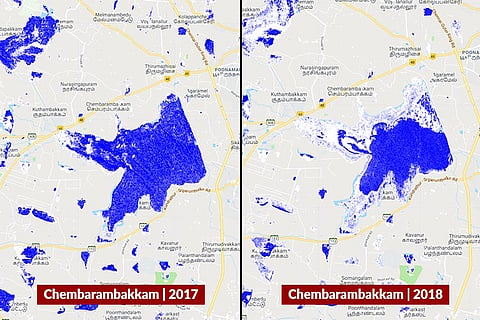

Tamil Nadu's capital city is heading towards a potential drought like situation in 2019 with the northeast monsoons bringing in very little rainfall. Chennai is now staring at a 54%-deficit in rainfall and lakes surrounding the city, which are important sources of water, are drying up.
According to S Janakarajan, Professor and Officiating Director at Madras Institute of Development Studies there are 3600 water bodies in Kanchipuram, Chennai and Tiruvallur districts, and 4,100 including those in Arakkonam. Despite the huge number of water bodies, we are staring at a deficit. The shortage of rainfall this season has threatened to dry up several lakes on the outskirts of Chennai, including Poondi, Cholavaram, Redhills and Chembarambakkam, which supply drinking water to the city.
While experts point out that this could cause a repeat of the drought faced by the state in 2017, radar satellite images prepared by Raj Bhagat P of the World Resources Institute (India) show that situation could be much worse.
These nine maps compare satellite images of these waterbodies in December 2017 and 2018, to show that there is a stark reduction in the availability of water in these lakes. In the following maps, the dark blue regions represents the water body while the light blue portions are the wet soil around it.
The Chembarambakkam lake is located 25 kilometres from Chennai and is a rain-fed reservoir.
The Poondi lake is situated in Tiruvallur district and is 60 kilometres from Chennai.
In this map, you can see the reduced water levels in both the Redhills and Cholavaram reservoirs. The Puzhal lake is also rain-fed and an important source of water.
The Kaveripakkam lake is located in Vellore district and is about 100 kilometres from Chennai.
The Manimangalam lake is located in Kancheepuram district and is part of the Kudimaramath scheme, an ancient method of constructing and maintaining waterbodies by the local community.
The Cheyyar river runs through Tiruvannamalai district and is a seasonal river. While the river itself has not seen much of an impact due to insufficient rains, water bodies around it have seen depletion of water.
The Mathuranthakam lake is an aritificial water body located in Kancheepuram district.
The Tenneri lake is located in Kancheepuram district and augments Chennai's water supply.
Poor water management
"The monsoon has been very bad and that is definitely a cause for the lower levels of water. However, we must accept that the second reason is poor demand management," says Raj Bhagat P, Senior Project Associate of WRI India. "Even when we have surplus water, we don't plan the water management based on future needs. When supply is more, consumption pattern changes causing over consumption," he adds.
Arun Krishnamurthy, founder of Environmentalist Foundation of India (EFI), points out that the increasing number of borewells is a huge strain on water bodies and water retained underground.
"First, there are no steps taken for rejuvenation of water and over the years utilisation of water is just increasing for agriculture, domestic use and industry. If you keep taking and give nothing back, this is bound to happen," he says.
All images Processed by Raj Bhagat Palanichamy; Contains Modified Copernicus Sentinel Data [2017,2018]